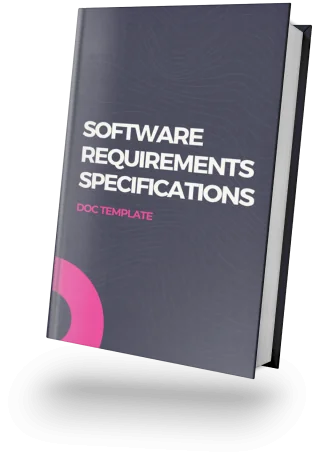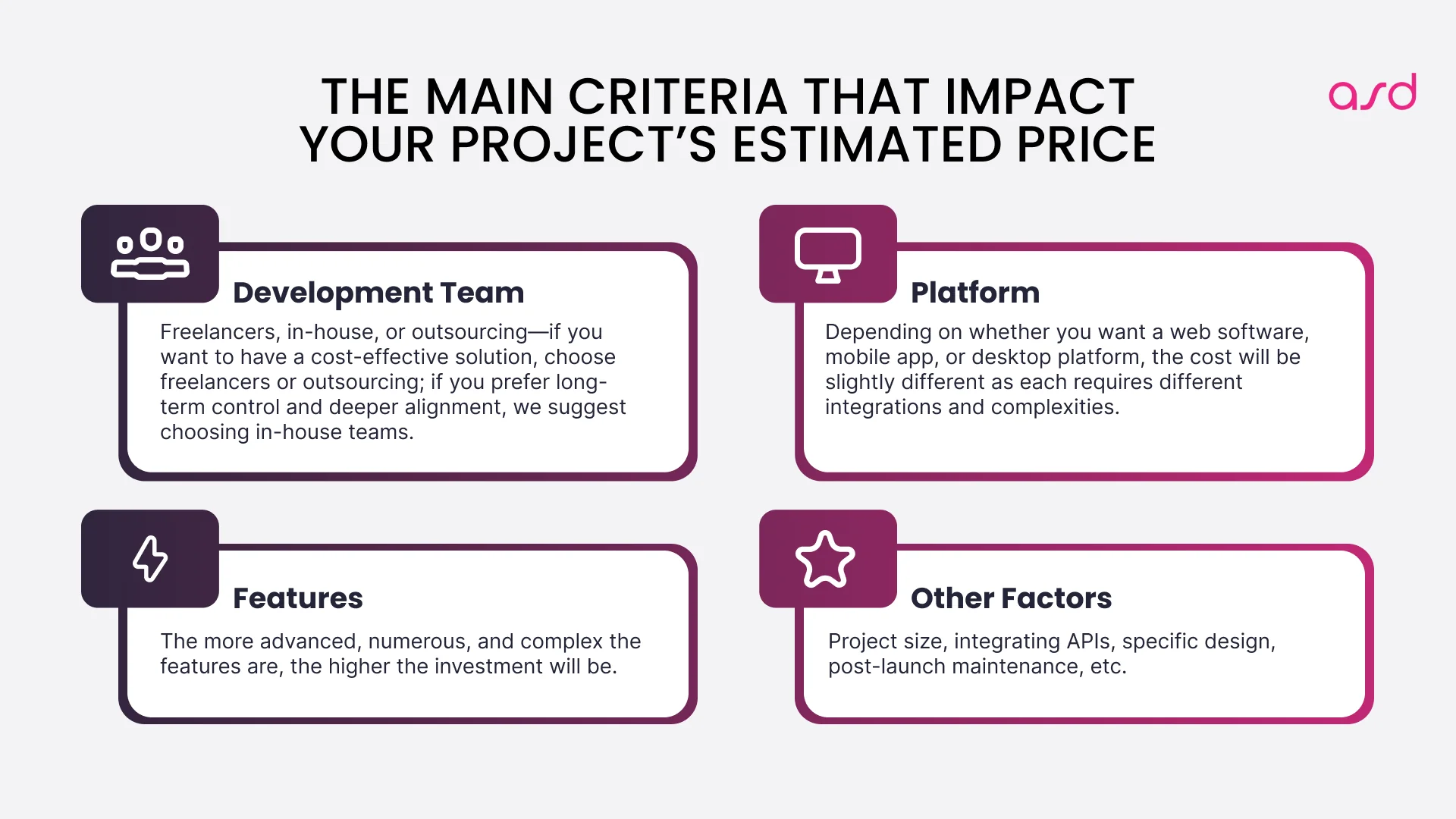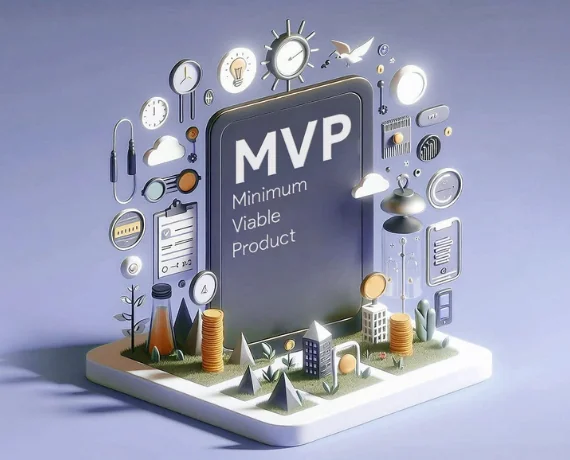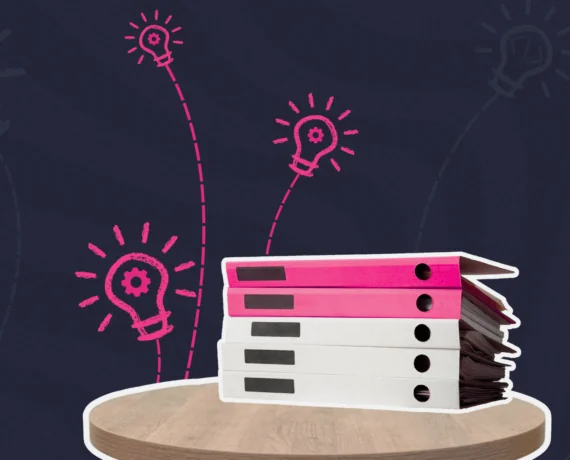Table of Content
- Introduction to Software Development
- Building the full version right away vs. Building an MVP
- The major part of how to develop software from scratch
- The process for building a software product from scratch
- Building the Development Team
- Development Methodologies and Tools
- How much does it cost you to build custom software from scratch?
- How long does it take to develop software from scratch?
- Monitoring and Feedback
- How to develop software from scratch: Final Words
Develop Your Idea into a Powerful Software
Book a callHave you been pondering on a software idea you want to build from scratch but know nothing about developing software? What should you do first? Project planning is crucial as it helps define the project scope, team composition, and timelines. Which programming language or framework to use? Should you pay someone to do it, or should you take the DIY route and do the work yourself? And you probably have many more questions with no answer… yet. We get it; with over 15 years of experience in software development, we can agree that this is no easy thing when you know nothing about this intricate skill. Read further if you want to discover more about how to build software from scratch — whether you need an MVP, step-by-step framework for building your software, development costs, and development duration.
Introduction to Software Development
Software development is the intricate process of designing, creating, testing, and maintaining software applications. It encompasses a series of well-defined steps, starting from the initial conceptualization of an idea to the final deployment of a fully functional software product. This journey requires a deep understanding of various programming languages, software development methodologies, and a suite of tools designed to streamline the development process.
Developing software from scratch can be a daunting task, especially for those new to the field. However, with the right approach and expertise, it can also be an incredibly rewarding experience. The software development process involves several key stages, including requirement gathering, planning, designing the software architecture, actual development, rigorous testing, deployment, and ongoing maintenance. Each of these stages plays a crucial role in ensuring that the final product meets the desired quality standards and fulfills the needs of its users.
Whether you’re a business owner looking to create custom software solutions or an aspiring software developer eager to bring your ideas to life, understanding the fundamentals of software development is essential. By mastering the development process, you can transform your vision into a tangible, high-quality software product that stands out in the market.
Building the full version right away vs. Building an MVP
When you have a software idea, it may be tempting to jump straight to building a fully-fledged product containing all the features you desire. You feel excited about your startup, so you want it to be perfect. You don’t want to lose credibility by launching something “incomplete” and be considered not valuable enough. While dreaming big and wanting to turn your idea into reality as fast as possible is understandable, this is not the right approach. Especially when you have a startup and don’t know much about creating your own software from scratch. Here’s why:
- Risk of Losing Money and Time: At first, you don’t have any proof or real feedback of what your users may want, so you waste resources on features that are not in demand.
- Missing Out On Market Opportunities: While you spend time continuously adding new features, refining, and adding extra unnecessary functionalities, your competitors could overtake you and be the first to launch a product similar to yours.
- Overload of Technical Work and Complexities: By adding too many features and functionalities right from the beginning, the codebase becomes more and more complex and harder to maintain or develop.
- Very Difficult To Adjust or Change Direction: Having a fully developed product means you already invested a lot of time, effort, and resources, which makes it really challenging to change your approach even if the data and feedback suggest you should.
Creating a project plan that outlines goals, deliverables, and performance indicators is crucial. It helps streamline the overall project management and ensures stakeholder expectations are met throughout the software creation process.
What’s a smarter approach? – Build an MVP
An MVP is a younger version of your product, with fewer features and capabilities, but it emphasizes the best ones. This will give you the chance to get insights on what your target audience needs and wants… Test if your idea is truly in demand, and take the risk out of the equation. Developing this early version of your product first (MVP) will save you from all of the struggles listed above and help you build top-notch software that people actually need and want to use… While still maintaining the flexibility to adjust or even switch your approach. Want to discover more about whether you need an MVP, how it’s crucial, and how to build one?
Discover about how to build an MVP and how long it takes
The major part of how to develop software from scratch
Before moving on to the actual software development process, it’s really important to clearly understand and lay out your specific software requirements. This part implies documenting things like project scope, functional requirements, user stories, and any other specifications that will ensure stakeholders have a clear understanding of your project’s needs. Business analysts play a crucial role in gathering and assessing business needs, defining necessary features and functionalities, and identifying potential risks, ensuring compliance with industry regulations. You may be interested in our article on how to develop software requirements and why they are important in software development.
Software Requirements Specifications


The step-by-step process for building a software product from scratch
Further, you will see each step we take for building software, covering the entire process from getting a clear understanding of our client’s idea to creating a well-performing product ready to welcome users.
![]()
![]()
Step 1: Requirement creation
Whether you choose to work with an MVP software development team or do this by yourself, this step is crucial for making sure the end result will align with your initial vision. This is how we do it:
- Getting a clear understanding of the client’s idea, software requirements, and vision to make sure we deliver up to expectations. Defining functional modules during this phase is essential to outline the key components and capabilities required for the software.
- Thoughtfully researching the market, such as competitors, seeing where the product can stand out, and the target audience, seeing how we can best meet their needs.
- Collaborate with stakeholders to clarify the feature request, discuss objectives and roadblocks, and set priorities to ensure everyone is on the same page.
Step 2: Planning
Project planning is crucial in creating a comprehensive project plan by breaking down the project into smaller manageable tasks, setting deadlines, and setting clear priorities. This phase ensures that steps are not skipped and everything runs smoothly.
- Identify the most valuable features you want to prioritize, then organize them into smaller milestones with clear deliverables and timelines for each.
- Assign and compose team members to certain tasks for a more effective working flow.
- Predict and plan for potential challenges that could come up during the development process, such as technical, operational, or logistical errors.
Step 3: Architecture the software
Now we are making your software look good and aesthetically pleasing. Here it’s all about creativity and aligning the software design with your initial vision.
- Choose the right technology stack—programming language, libraries, frameworks, and tools that best fit the type of project you have. Selecting the right programming languages for backend development, such as Java, PHP, Ruby, Python, and C#, is crucial for building robust and efficient software applications.
- Define how different modules will interact internally with external systems to ensure a seamless data flow.
- Design a working and scalable architecture, including main components, data flow, and interactions between different systems.
Step 4: Development
Here your software slowly starts to develop and become functional. This involves building the software, integrating any necessary third-party services, and implementing the required features.
- Build upon prioritized features chosen at the beginning of the software development process.
- Writing server-side code is crucial before tackling client-side development to ensure the backend achieves the desired standards in code quality and project expectations.
- Start incorporating necessary third-party integration and APIs, such as payment gateways, cloud services, authentication, etc.
- Test and examine the code to spot any issues that need to be fixed before moving forward
Looking for a tech partner for your startup?
Our team has talented experts who can help you develop your product.
Let’s talk
Looking for a tech partner for your startup?
Step 5: Testing
The goal of the testing step is to make sure that your software is secure, runs smoothly, and meets all the established requirements before going live.
- Ensure that all your features, different modules, and any third-party integrations work as intended and interact seamlessly without issues. Integration tests are crucial in this phase to ensure all components of the software function correctly together.
- Check if the software’s performance is optimal by testing it under various conditions (such as load testing) and identify any unwanted vulnerabilities or system breaches that may occur.
- Lastly, have some users or stakeholders test your software in real-world scenarios, testing its capabilities and making sure it meets expectations and is ready for launch.
Step 6: Deployment
It’s time to go live. This step involves preparing and launching your software while making sure it runs smoothly and is stable for usage.
- Now it’s time to make some final rounds of testing to confirm that the user experience will be as intended. Check servers, databases, and configurations. A DevOps engineer plays a crucial role in managing servers, deploying updates, and integrating CI/CD pipelines to ensure a seamless deployment process.
- Perform some training sessions (onsite, remote, or hybrid) to help users better understand how to use your software effectively and address any questions or issues.
- Keep an eye out for immediate issues or bugs that may appear to ensure continuous stability and user satisfaction.
Step 7: Maintenance and continuous development
Your job is not finished. While monitoring your software performance, continuously keep it up to date by making improvements, collecting user feedback, and adding new features that are in demand.
- Monitor your software’s performance daily, ensuring no issues may disrupt your users. Utilizing software monitoring tools can help track performance metrics and ensure the software remains reliable and secure.
- Collect user feedback and learn more about what your market needs and wants to discover new opportunities for features and improvements.
- Ensure you regularly provide user support to ensure their positive experience while using your software.
Building a software development team is a pivotal step in the software development process. A well-structured team is the backbone of any successful software project, ensuring that each phase of development is executed with precision and expertise. The composition of your team can significantly impact the quality and efficiency of the development process.
A typical software development team includes several key roles:
- Project Managers: They oversee the entire project, ensuring that it stays on track, within budget, and meets all deadlines. Project managers are responsible for coordinating between different team members, managing resources, and addressing any issues that arise during the development process.
- Software Developers: These are the individuals who write the code that brings the software to life. They work on both the front-end and back-end development, ensuring that the software is functional, efficient, and user-friendly.
- Quality Assurance Engineers: QA engineers are responsible for testing the software to identify any bugs or issues. They ensure that the software meets all quality standards and performs as expected under various conditions.
- DevOps Engineers: They focus on the deployment and maintenance of the software. DevOps engineers work to streamline the development process, automate tasks, and ensure that the software runs smoothly in the production environment.
Each team member should have a clear understanding of their role and responsibilities, as well as the skills and expertise required to deliver high-quality software applications. Effective communication and collaboration within the team are crucial for the success of the project.
Development Methodologies and Tools
Choosing the right development methodology and tools is essential for the success of any software project. Different methodologies offer various approaches to managing the development process, each with its own strengths and weaknesses.
- Agile Development: Agile is an iterative and incremental approach that emphasizes flexibility, collaboration, and customer feedback. It involves breaking the project into small, manageable sprints, allowing the team to deliver functional software increments regularly. Agile development is ideal for projects where requirements may evolve over time, as it allows for continuous improvement and adaptation.
- Waterfall Development: In contrast, the Waterfall methodology is a linear approach that emphasizes predictability and control. It involves completing each phase of development sequentially, from requirement gathering to deployment. Waterfall is best suited for projects with well-defined requirements and minimal changes expected during the development process.
The choice of development tools also plays a crucial role in the efficiency and effectiveness of the development process. Integrated Development Environments (IDEs), version control systems, and project management tools are just a few examples of the tools that can support your chosen methodology. The right combination of methodologies and tools can streamline the development process, improve collaboration, and ensure the timely delivery of high-quality software.
How much does it cost you to build custom software from scratch?
Giving an exact estimate of the expected investment can be almost impossible. The price range can vary widely, each project being unique. Here are some of the main criteria that impact your project’s estimated price:
- Development Team: Freelancers, in-house, or outsourcing software development — if you want to have a cost-effective solution, choose freelancers or outsourcing; if you prefer long-term control and deeper alignment,, we suggest choosing in-house teams.
- Platform: Depending if you want a web software, mobile app, or desktop platform, the cost will be slightly different as each requires different integrations and complexities.
- Features: The more advanced, numerous, and complex the features are, the higher the investment will be.
- Other Factors: Project size, integrating APIs, specific design, post-launch maintenance, etc.

Knowing all these, it can still be complicated to evaluate the estimated price of your entire software development process… But we created a free quiz that will help you with that. If you want to know how much it costs to build software, you can get a more accurate estimation for your specific project by taking our free software project estimation quiz.
How long does it take to develop software from scratch?
Estimating time for a development project can be slightly easier than calculating the costs, but it can still vary widely based on several factors — from the complexity of the project and expertise of the development team you choose to work with to details like the tech stack, the number of specific project requirements, and the difficulty of each. Effective project management is crucial in planning, monitoring, and delivering software projects on time. Each aspect can add a considerable amount of time and effort to the development process. To get an idea of the estimated time it will take you to develop your software, here’s a general breakdown of timelines for different types of software projects:
1. Simple Applications (2-3 months)
- Basic mobile apps, small websites, or simple-to-build tools.
- Projects that have limited functionality, few features, and a minimal user interface design.
Frontend development is crucial for these projects, utilizing key languages and frameworks such as HTML, CSS, JavaScript, and popular frameworks like Vue, Angular, and React to create the user interface.
2. Moderate Complexity (4-9 months)
- E-commerce websites, content management systems, or a feature-rich mobile app.
- Projects involving a more extensive feature set, integration with third-party services, and moderate design complexity.
3. Complex Applications (9-18 months)
- Enterprise software, large-scale web applications, or custom CRM systems.
- Projects with complex business logic, extensive database management, high-security requirements, and integrations with multiple systems.
App development is crucial in creating solutions that enhance business operations, ensuring that software architecture design and project planning are meticulously executed.
4. Highly Complex Systems (18+ months)
- Multi-platform enterprise systems, cloud-based services, and large-scale SaaS products.
- Large systems that require continuous development, scaling, and iteration, often involving multiple teams and ongoing updates.
Factors Affecting Development Time
- Requirements Clarity: Clear and well-defined requirements can speed up the process, while changes and ambiguity can cause delays.
- Team Size and Expertise: Larger or more experienced teams can handle complex tasks faster, though larger teams also require more coordination.
- Technology Stack: Some technologies may allow for faster development due to existing libraries or frameworks, while others might be more time-consuming.
- Project Management: Efficient project management practices can significantly reduce delays and improve time estimates. A thorough cost-benefit analysis is crucial in evaluating return on investment (ROI) and ensuring that project resources are allocated effectively.
- Ongoing Development: Many software projects require ongoing development after the initial launch for maintenance, bug fixes, updates, and new feature development. This can extend the timeline significantly, sometimes indefinitely.
- Agile and Iterative Approaches. Many teams use Agile methodologies, breaking the project into sprints of 2-4 weeks and delivering increments of the software. This allows for ongoing development and adaptation but can make it challenging to pinpoint a final “completion” date.
Monitoring and feedback are critical components of the software development process, ensuring that the software performs well and meets user expectations. Effective monitoring involves tracking various metrics such as user engagement, conversion rates, and customer satisfaction. This data provides valuable insights into how users interact with the software and highlights areas that may need improvement.
User feedback is equally important, as it offers direct insights into the user experience. Collecting feedback can be done through surveys, feedback forms, and user testing sessions. This feedback should be analyzed and used to make informed decisions about future updates and improvements.
A robust feedback process includes a plan for responding to user feedback and making necessary changes. This iterative approach ensures that the software continues to evolve and improve, meeting the changing needs of its users. By actively monitoring performance and gathering user feedback, you can ensure that your software remains relevant, functional, and user-friendly.
By integrating these new sections, the article will provide a comprehensive guide to building a software product from scratch, covering all essential aspects from conceptualization to continuous improvement.
How to develop software from scratch: Final Words
These are the basics you need to know about how to build software from scratch…
The bad news is that learning how to build software from scratch can be harder than it looks… You keep bumping into problems such as defining clear requirements, communicating with your team, choosing the right technology stack, and many more. Especially when you never had contact with anything related to software development before.
Newcomers often face a steep learning curve due to the various complexities and variables involved in software development. Adequate training and knowledge are crucial for developers to navigate these challenges effectively.
However, imagine finally having the product you initially envisioned become a reality and having real users benefit from what your software has to offer. We can all agree that having your software a click away is something magical. If you choose to take on the challenge yourself, we wish you good luck! While your process may be very demanding and things may not go the way you want, having your software helping people is worth it. If you think you would rather invest this time and energy into other business or personal life aspects and would prefer having an experienced software development team take this burden off of you.
We are here to help you! From listening and clearly understanding your special requirements to bringing your idea to life by building and launching your software to the market with our MVP development service. Minimal efforts from your side.
Many people end up building the wrong software due to unclear requirements or a change of direction during the development process. This miscommunication often leads to misalignment and makes it hard to create the wanted software.
Building your own software consists of several key steps. First of all, you need to clearly define your idea and goal for the project, conduct a structured plan, market research, followed by the actual development and design of the software. In the end, carefully test and improve the software to prepare for release. Once released, ensure it gets regular maintenance and support.
Speed comes with a well-organized plan, good automation, and effective communication within the team. Clearly outline your goals and prioritize tasks; set up existing tools and automation to help you fast-track the testing and deployment process; and maintain clear communication within your team, each member knowing when, how, and what he has to do.
This can be done by building a Minimum Viable Product (MVP) that only prioritizes the most essential features. This will help you get real feedback from real users and see whether your software is in demand, what to improve, and what features you should add. This will avoid all the risks that come with jumping straight to full-package software, such as losing money, time, and time-to-market.
Let’s talk about your project? Feel free to ask any additional questions you might have. Our experts will be glad to assist you.

Questions? Answers!
Why is it so difficult to build the correct software?
Many people end up building the wrong software due to unclear requirements or a change of direction during the development process. This miscommunication often leads to misalignment and makes it hard to create the wanted software.
How can I develop my own software?
Building your own software consists of several key steps. First of all, you need to clearly define your idea and goal for the project, conduct a structured plan, market research, followed by the actual development and design of the software. In the end, carefully test and improve the software to prepare for release. Once released, ensure it gets regular maintenance and support.
How to develop software faster?
Speed comes with a well-organized plan, good automation, and effective communication within the team. Clearly outline your goals and prioritize tasks; set up existing tools and automation to help you fast-track the testing and deployment process; and maintain clear communication within your team, each member knowing when, how, and what he has to do.
How do I validate my software idea before building software from scratch?
This can be done by building a Minimum Viable Product (MVP) that only prioritizes the most essential features. This will help you get real feedback from real users and see whether your software is in demand, what to improve, and what features you should add. This will avoid all the risks that come with jumping straight to full-package software, such as losing money, time, and time-to-market.




